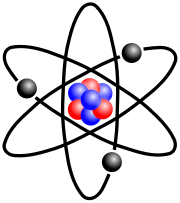Welcome back to PinchOfKCN's lesson! Are you currently enjoying your long-long four day weekend? Today we are very fortunate to have Professor Snape teaching us Chemistry, and as we all know, he is an excellent potions master; I'm sure you will like his lesson. As I can see, you guys are all very EXCITED, jumping up and down. But I should warn you that you may not want to upset Professsor Snape, or else he'll hit you in the head without mercy.
Back to today's lesson, our topic of the day is "the electronic structure of the atom", which means, we are going to find out how electrons in a certain element distribute themselves, as well as how many of them are circling around in their orbital.
Energy / Orbital Levels
When you are a kid, have you ever upset your mom because you never sit on a chair quietly? And perhaps your mom would then be so angry and suspect that you have
Hyperkinetic Disorder? Well, this is what happens to an electron with high a energy level. When one or more electrons have energy levels greater than their ground state (lowest possible energy levels), they will jump up to a higher orbital level. (The energy level is represented by "n").
There are four types of orbitals, they are each referred by a different alphabet, s,p,d and f.
On the right, you can see the chart of electron configuration, starting with 1s, it is the first energy level. In different energy level, there will be a set of orbitals which allow electrons to occupy:
Level 1 (n=1): s type
Level 2 (n=2): s and p type
Level 3 (n=3): s, p and d type
Level 4 (n=4): s, p, s and f type
Here's a sample question: What is the electron configuration of the element Calcium in it's neutral state?
First, you will have to determine how many electrons in calcium. Look at your trusty BFC (a.k.a. Periodic table), and you should be able to tell it has 20 electrons. (If you are not able to get that number, then I'd say you were not paying enough attention during Ms.Chen's chemistry class)
Next, start filling in each orbital until you've "used up" all the electrons.
The following is a list of orbitals that each subshell has (note: the number inside the brackets=number of orbital):
1s(1), 2s(1), 2p(3), 3s(1), 3p(3), 3d(5), 4s(1), 4p(3), 4d(5), 4f(7)
Electron configuration for calcium:
1s2,2s2,2p6,3s2,2p6,4s2
Core notation can be used to simplify configuration writings, we use a set of the nearest noble gas element to represent Chemistry teachers claimed that they can help make things easier, but I think it just confuses us even more.
Here's a sample question:
Write the configuration using core notation for the element Potassium.
As you all know, potassium has 19 electrons, and if we have to write it's configuration without core notation, it'll be 1s2,2s2,2p6,3s2,3p6,4s1.
But now, we would like to simplify it, so we'll find the noble gas which has the nearest number of electron as potassium. Yes, it is argon. Argon has 18 electrons, and potassium has 19. So, we'll replace the configuration of 18 electrons with the symbol [Ar]. As a result, the final answer would be [Ar] 4s1.
Easy? Nah~ I'd say no. The hard part about core notation is that you'll have to figure out the remaining electrons AND transform it into configuration.
Now, it seems like the following three handsome guys have something important to say, and these are the concluding rules that you'll have to remember when writing configurations:
The Pauli Exclusion Principle
In 1925, Wolfgang Pauli proposed this principle to describe the arrangements of electrons in an atom. He suggested that protons and neutrons always obey the same rule, where electrons do not, where a certain amount of electrons can be placed in a given quantum state. Which is, in every given energy level, only a limited number of electrons can be placed. And in fact, he's right. Each orbit can have up to 2 electrons. If Pauli is wrong, then all the electrons will be pilling up in the first energy, which is, obviously impossible. Pauli also proposed no two electrons can occupy the same state inside a closed system. (state=properties of an electron)
The Aufbau Principle
Our trusty Mr.Pauli did not only propose the exclusion principle; along with the famous Niels Bohr, they together created the Aufbau Principle (Also known as the "Application of quantum mechanics to molecular construction"). This principle suggested that lower energy level orbits should be filled before those of higher energy levels, where electrons should be added to an atom or a molecular system, and they will be interacting with the existing protons and neutrons.
(Side note: the word "Aufbau" means "building out" in German)
The Hund's Rule
Friedrich Hund propsed a law that every electron will only pair up when the previous orbital is fully occupied, and they will pair up with electrons with similar energy (aka: degenerate)
So that's pretty much all about electron configuration.
Confused? Huh? Well I'd say you're a genius if you are not. So here's a
secret trick for you to find the electron configuration of any element very very easily.
But please do not leak the trick, or else it won't be a secret anymore, will it?
First, you will have to
memorize know the distribution of different energy levels. A periodic table is shown below:
Then, let's say, you want to find the electron configuration for the element Sulfur. First, figure out how many electrons do carbon have. By look at your BFC, you will get the number 16.
Next, count horizontally, the number of elements on each row, until you reach sulphur. In this case, on the
first row, there are
2 elements, hydrogen and helium. They both belong to the
s-type orbital. As a result, we will write down "1s2".

Then go on to the
second row, there are
2 s-type elements and
6 p-type elements, so you'll write "2s2, 2p6". Same for the
third row, there are
2 s-type elements and
4-p type elements until you reach sulphur, so you'll write "3s2, 3p4". Combining the configurations above, you'll get "1s2,2s2,2p6,3s2,3p4".
Easy? Yes, I think it is.
Well, that pretty much wraps up our lesson for today, I'll wish you a happy long weekend and a good luck, because I, Sybill Trelawney, the professor of Divination at Hogwarts School of Witchcraft and Wizardry, predicts that you guys will be having a quiz or test very soon.
Friendly reminder:
Do not forget about your chemistry research project on the scientists as well! ;)
(Warning: This is
NOT a joke)



























